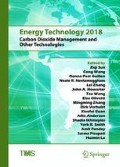Abstract
Recovery of trace elements from different industrial waste streams is important in realizing the goals of the circular economy. Ash streams from waste combustion can contain high levels of both toxic and valuable trace elements. These elements can be separated during the combustion process based on volatilization and condensation, as well as being separated in post-combustion processes, through thermal or leaching treatment. In this study, an overview is given of the thermal methods for recovery of valuable elements from ash fractions derived from waste incineration. In addition, a case study is presented of the behaviour of ash-forming elements in combustion of MSW and demolition wood, with special focus on the elements Co, Cu, and Sb. In conclusion, it is shown that thermodynamic modeling of high temperature processes can be a useful tool to predict ash behavior both during combustion and in the post combustion treatment of the ash.
Access this chapter
Tax calculation will be finalised at checkout
Purchases are for personal use only
References
van der Sloot HA, Kosson DS, Hjelmar O (2001) Characteristics, treatment and utilization of residues from municipal waste incineration. Waste Manag 21:753–765
Sabbas T, Polettini A, Pomi R, Astrup T, Hjelmar O, Mostbauer P, Cappai G, Magel G, Salhofer S, Speiser C, Heuss-Assbichler S, Klein R, Lechner P (2003) Management of municipal solid waste incineration residues. Waste Manag 23:61–88
Quina MJ, Bordado JC, Quinta-Ferreira RM (2008) Treatment and use of air pollution control residues from MSW incineration: an overview. Waste Manag 28:2097–2121
Whiticar DM, Ralph J (2011) Waste to energy. A Technical Review of Municipal Solid Waste Thermal Treatment Practices—Final Report. Stantec Consulting Ltd, p 339. http://www.env.gov.bc.ca/epd/mun-waste/reports/pdf/BCMOE-WTE-Emissions-final.pdf
Zacco A, Borgese L, Gianoncelli A, Struis RPWJ, Depero LE, Bontempi E (2014) Review of fly ash inertisation treatments and recycling. Environ Chem Lett 12:153–175
C. IAWG (International Ash Working Group) AJ, Eighmy TT, Hartle´n O, Kosson D, Sawell SE, van der Sloot H, Vehlow J (1997) Municipal solid waste incinerator residues. studies in environmental science. Elsevier
Lindberg D, Molin C, Hupa M (2015) Thermal treatment of solid residues from WtE units: A review. Waste Manag 37:82–94
Tanigaki N, Manako K, Osada M (2012) Co-gasification of municipal solid waste and material recovery in a large-scale gasification and melting system. Waste Manag Oxford, U. K. 32:667–675
Jung CH, Matsuto T, Tanaka N (2005) Behavior of metals in ash melting and gasification-melting of municipal solid waste (MSW). Waste Manage Amsterdam Neth 25:301–310
Arena U, Di Gregorio F (2013) Element partitioning in combustion- and gasification-based waste-to-energy units. Waste Manage Oxford, U. K. 33:1142–1150
Ljung A, Nordin A (1997) Theoretical feasibility for ecological biomass ash recirculation: chemical equilibrium behavior of nutrient elements and heavy metals during combustion. Environ Sci Technol 31:2499–2503
Obernberger I, Biedermann F (1997) Fractionated Heavy metal separation in biomass combustion plants-possibilities, technological approach, experiences. In: The impact of mineral impurities in solid fuel combustion, Engineering Foundation, New York, United States, Kona, Hawaii, USA
Obernberger I, Biedermann F, Widmann W, Riedl R (1997) Concentrations of inorganic elements in biomass fuels and recovery in the different ash fractions. Biomass Bioenerg 12:211–224
Kangas P, Koukkari P, Lindberg D, Hupa M (2014) Modelling black liquor combustion with the constrained Gibbs energy method. J Sci Technol For Prod Process 3:6–15
Kangas P, Koukkari P, Brink A, Hupa M (2015) Feasibility of the constrained free energy method for modeling NO formation in combustion. Chem Eng Technol 38:1173–1182
Bale CW, Bélisle E, Chartrand P, Decterov SA, Eriksson G, Hack K, Jung I-H, Kang Y-B, Melançon J, Pelton AD, Robelin C, Petersen S (2009) FactSage thermochemical software and databases—recent developments. CALPHAD: Comput Coupling Phase Diagr Thermochem 33:295–311
Lindberg D, Backman R, Chartrand P (2007) Thermodynamic evaluation and optimization of the (NaCl + Na2SO4 + Na2CO3 + KCl + K2SO4 + K2CO3) system. J Chem Thermodyn 39:1001–1021
Vainio E, Lindberg D, Yrjas P (2015) Characterisation and on-line measurements of ashes—continuous leaching analysis of ashes. Arvi - material value chains, project report. https://portal.cleen.fi/_layouts/IWXmlPublications.aspx?Source=ARVI&FileId=265
Lindberg D, Vainio E, Yrjas P (2015) Critical review of thermodynamic data for heavy metals in aqueous solutions and thermodynamic calculations of solubility of heavy metal compounds in ash. Arvi—material value chains, project report. https://portal.cleen.fi/_layouts/IWXmlPublications.aspx?Source=ARVI&FileId=266
Laine-Ylijoki J, Bacher J, Tommi Kaartinen K, Korpijärvi M, Wahlström M, Castell-Rüdenhausen z (2015) Review on Elemental Recovery Potential of Ashes. Arvi—material value chains, project report. https://portal.cleen.fi/_layouts/IWXmlPublications.aspx?Source=ARVI&FileId=220
Vainio E, Hupa E, Eriksson J-E, Lindberg D, Yrjas P (2017) Continuous leaching analysis of ashes. Arvi—material value chains, project report. https://portal.cleen.fi/_layouts/IWXmlPublications.aspx?Source=ARVI&FileId=689
Acknowledgements
The study was performed within the ARVI-Material Value Chains Research Program, coordinated by CLIC Innovation Oy and financed by Tekes – the Finnish Funding Agency for Innovation.
Author information
Authors and Affiliations
Corresponding author
Editor information
Editors and Affiliations
Rights and permissions
Copyright information
© 2018 The Minerals, Metals & Materials Society
About this paper
Cite this paper
Lindberg, D., Vainio, E., Yrjas, P. (2018). Thermal Separation and Leaching of Valuable Elements from Waste-Derived Ashes. In: Sun, Z., et al. Energy Technology 2018 . TMS 2018. The Minerals, Metals & Materials Series. Springer, Cham. https://doi.org/10.1007/978-3-319-72362-4_21
Download citation
DOI: https://doi.org/10.1007/978-3-319-72362-4_21
Published:
Publisher Name: Springer, Cham
Print ISBN: 978-3-319-72361-7
Online ISBN: 978-3-319-72362-4
eBook Packages: Chemistry and Materials ScienceChemistry and Material Science (R0)

